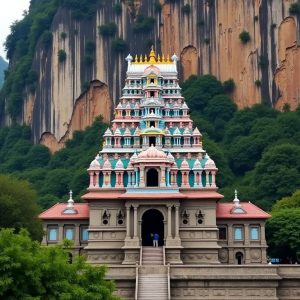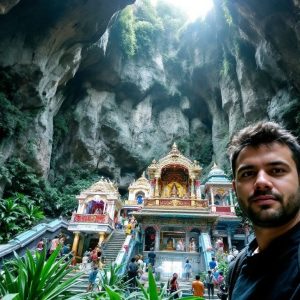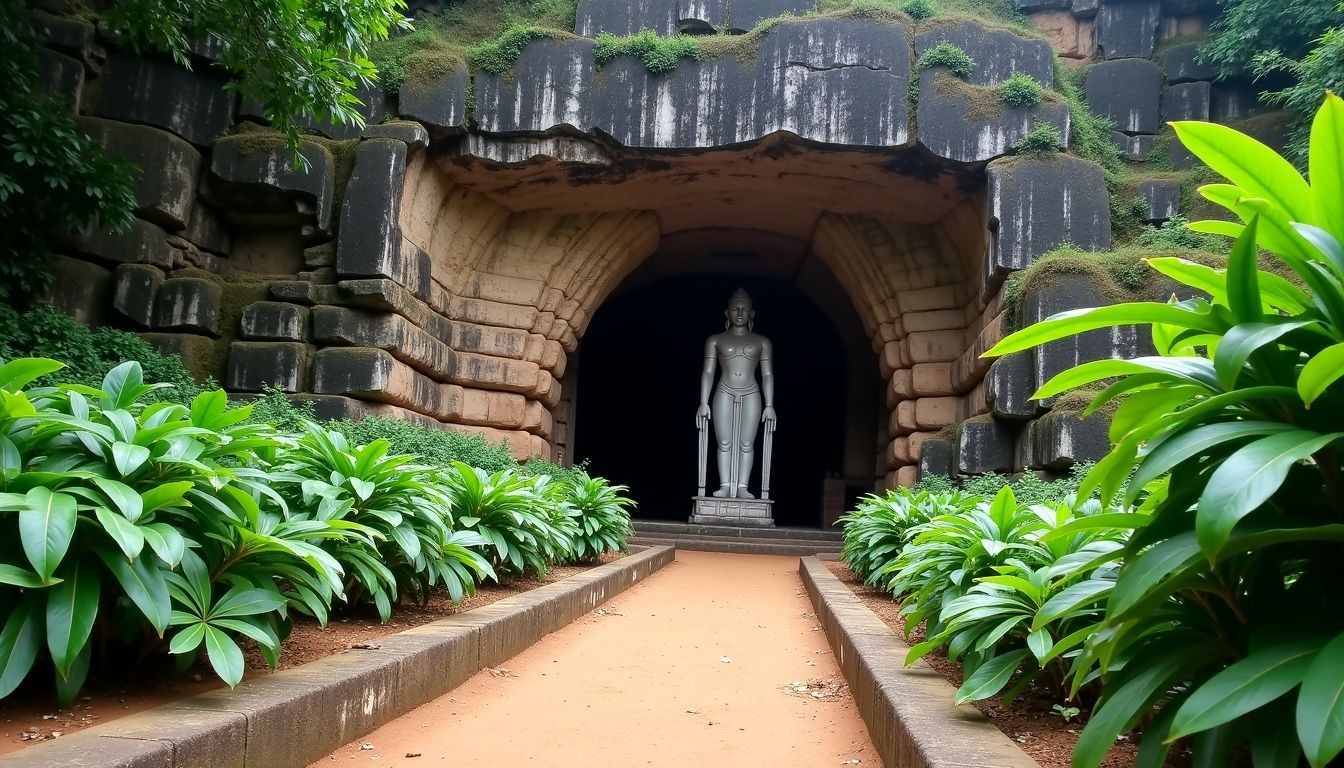Batu Caves, a stunning cultural site in Malaysia, holds deep history and meaning. Discovered in the late 19th century, it quickly gained importance. The caves became even more famous after major developments in the 1920s.
Visitors are drawn by its connection to Tamil Hindu traditions—especially Thaipusam, which attracts thousands each year.
A giant Lord Murugan statue towers proudly outside the caves, welcoming everyone. Inside, limestone formations and rich Tamil architecture blend beautifully with nature. Over time, modern touches have enhanced the experience for visitors while keeping its cultural charm intact.
Curious about what makes this place so special? Keep reading!
Historical Timeline of Batu Caves
Batu Caves has a rich past that spans over a hundred years. Its story includes key moments of discovery, worship, and change through time.
Discovery in the Late 19th Century
In the late 19th century, K. Thamboosamy Pillay introduced Batu Caves to the Tamil Hindu community. He saw its tall limestone cliffs and linked them to Lord Murugan, an important deity in Hinduism.
Soon after, he placed a statue of Lord Murugan within the caves.
Interest grew quickly! By the late 1800s, this limestone hill became a religious site for pilgrims and visitors alike. Researchers also arrived, drawn by its historical significance and natural beauty near Kuala Lumpur.
These discoveries helped shape what we know about Batu Caves today.
Development in the 1920s
The 1920s marked a big change for Batu Caves. A lot of work began to make the place more special. The Tamil Hindu community worked hard to improve it as a religious site. They built proper stairs leading up to the limestone caves, which made visits easier and safer.
This was also when Batu Caves grew as an important space for the Thaipusam festival. More pilgrims started coming from Kuala Lumpur and nearby towns like Klang and Ipoh during this time.
Lord Murugan’s temples saw more visitors, boosting its role in Tamil culture in Malaysia.
Key Events in the 20th Century
Batu Caves became a major Hindu pilgrimage site in the 20th century. The Thaipusam Festival grew here, attracting thousands of Tamil Hindus. Devotees carried kavadis and climbed the steep 272 steps as part of their offerings to Lord Murugan.
In 1970, new temples and shrines were added, making the caves even more significant. The limestone caves saw renovations that included colourful structures and statues. This helped turn it into not just a religious site but also a well-known tourist attraction in Kuala Lumpur, Malaysia.
Modern Additions and Renovations
In recent years, colourful upgrades have transformed the 272 steps leading to the Temple Cave. These bright painted stairs now make every climb feel special—and picture-perfect for travellers.
The vivid hues have become a famous attraction, drawing visitors who love photography.
A new lighting system inside some limestone caves adds a magical glow. It helps us see the beauty of natural formations and Hindu shrines more clearly. Facilities like railings and rest areas improve safety and comfort for all guests exploring this religious site.
Cultural Significance of Batu Caves
Batu Caves stands as a cherished site for Tamil Hindus, filled with rituals and vibrant celebrations—read on to explore its sacred role.
Importance in Tamil Hindu Traditions
The caves hold deep meaning for the Tamil Hindu community. They honour Lord Murugan, a central figure in Tamil Hinduism. The golden statue of Lord Murugan outside is the tallest of its kind, standing at 42.7 metres.
Inside the temple cave, shrines reflect rich Tamil culture and faith. Devotees visit to offer prayers and perform rituals tied to their heritage. This site serves as a spiritual hub for Tamil Hindus in Malaysia and beyond.
Role in the Thaipusam Festival
Batu Caves becomes a vibrant Hindu pilgrimage site during the Thaipusam Festival. Devotees gather here to honour Lord Murugan, with many carrying colourful kavadis as acts of devotion.
The golden statue of Lord Murugan stands tall, watching over the rituals and prayers.
Millions visit from around the world every January or February for this celebration. We see worshippers climb the 272 steps while chanting and offering prayers at various altars inside the Temple Cave.
It’s a spiritual experience filled with culture, faith, and traditions unique to Kuala Lumpur’s Tamil community.
Architectural and Natural Features

The Batu Caves combine stunning limestone cliffs with sacred temples—truly worth exploring for their rich beauty and spiritual charm!
Limestone Formations
Limestone cliffs surround Batu Caves in Gombak, rising sharply against the sky. These cliffs are over 400 million years old. They form part of a stunning limestone hill and house various caves like Cathedral Cave and Dark Cave.
Nature shaped these formations into unique grooves and textures. The walls feel ancient, offering incredible photo opportunities. It’s amazing how such an age-old feature exists so close to Kuala Lumpur city centre!
The Murugan Statue
The limestone cliffs set the stage for something grand. Standing tall is the golden statue of Lord Murugan, an icon in Kuala Lumpur. This statue, at 42.7 metres, is the tallest Murugan statue in the world and shines brightly against the Batu Caves’ backdrop.
We marvel at its size and craftsmanship during each visit. Painted with 300 litres of gold paint from Thailand, it symbolises strength and faith for Tamil Hindus. Positioned beside the 272 colourful steps, it welcomes pilgrims during the Thaipusam festival—a religious event full of devotion and energy.
Temples and Shrines
Batu Caves boasts breathtaking temples and shrines nestled inside limestone caves. These sacred spaces hold deep meaning for the Tamil Hindu community in Malaysia. Inside the grand Temple Cave, colourful statues of deities like Lord Murugan stand tall, telling ancient stories through their designs.
We admire how each shrine blends with nature’s beauty. The Ramayana Cave is another highlight, showcasing carvings from the epic tale. Private guided tours allow us to explore these spiritual spots more deeply while appreciating their unique architecture and history.
Experiences at Batu Caves
The climb up the colourful 272 steps is both a challenge and an adventure. Watch out for cheeky monkeys—they love snacks!
Climbing the 272 Steps
We begin the climb at the foot of the golden Lord Murugan statue. There are 272 steps to reach the main Temple Cave. The view gets better as we go higher, showing Kuala Lumpur’s skyline, including landmarks like KL Tower and Petronas Twin Towers.
Monkeys run around near the stairs, adding fun (but hold your snacks tight!). Each step feels worth it—at the top awaits a stunning limestone cave filled with Hindu shrines and cultural beauty.
Interactions with Monkeys and Wildlife
After climbing the 272 steps, we meet some playful monkeys at Batu Caves. These cheeky creatures keep us on our toes. They swing around and grab anything within reach. Bags, snacks or even sunglasses are targets for their quick hands.
We also spot other wildlife near the limestone cliffs. Birds and lizards add to the natural charm of this religious site. It’s important to stay calm around them. Feeding the monkeys can lead to trouble—they might get too bold! Let’s enjoy watching them from a safe distance instead.
Nearby Attractions

Just a short trip away, you’ll find unique spots filled with adventure and charm. These places offer more to explore beyond the caves!
Dark Cave
The Dark Cave sits along the limestone cliffs of Batu Caves. This hidden spot is a treasure trove of nature and history. It houses rare species like the trapdoor spider, found nowhere else.
The cave also boasts unique stalactites and stalagmites, formed over millions of years.
We can explore it through guided tours that highlight its wonders. Bats, insects, and a cool atmosphere make this place feel magical yet mysterious. Proper footwear is important as paths may be slippery (but don’t worry—it’s safe).
Wildlife lovers will find this adventure unforgettable!
Selangor State Park
Just a short drive from the Dark Cave, Selangor State Park offers peace away from Kuala Lumpur’s busy streets. It covers over 108,000 hectares of lush forests and is home to rare plants and animals.
We love taking nature walks here, as it feels like stepping into a hidden world.
The park features hiking trails that suit different skill levels. Some paths lead to waterfalls—perfect for cooling down after a long walk. Wildlife lovers might spot birds or monkeys along the way.
This natural gem showcases Malaysia’s rich biodiversity while giving us plenty of spots for photos!
Conclusion
Batu Caves is a place full of history, culture, and beauty. It tells stories of faith and tradition through its caves, temples, and festivals. Climbing the steps feels like walking through time and wonder.
This spot holds something special for every traveller. Let’s explore it together!



Comment (0)